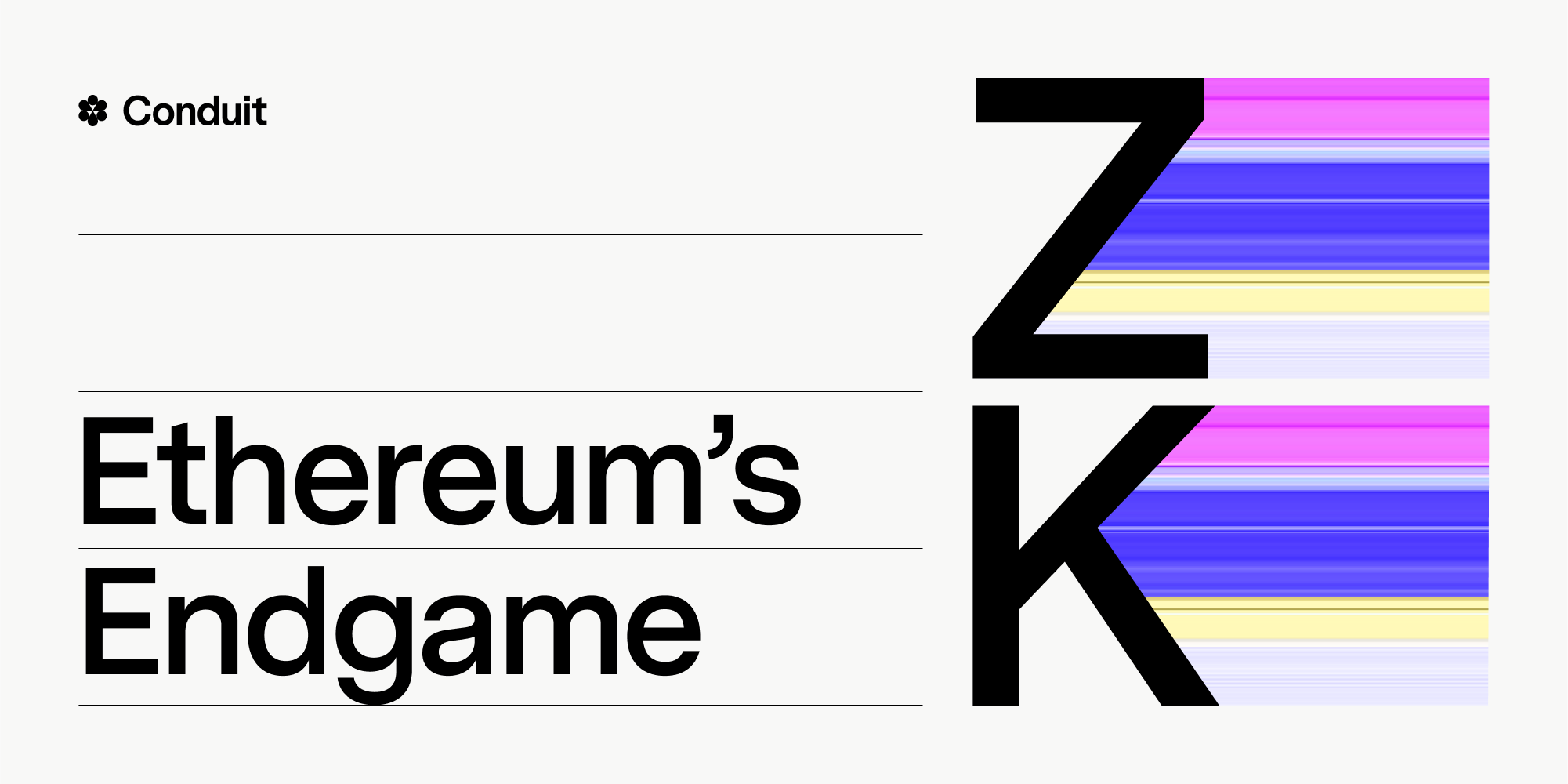The ZK Endgame: Rollup Interoperability Will Make Ethereum the Dominant Blockchain
ZK can solve rollups' interoperability problem and make Ethereum the dominant blockchain.

Over the last few months, there’s been a great deal of handwringing over the future of Ethereum. Is the foundation doing enough? Why is $ETH lagging behind $SOL? Do we need wartime Milady pfps?
Here’s your answer.
We believe that the incoming embrace of ZK proving systems, spurred by breakthroughs like OP-Succinct and RISC Zero Kailua, will put these questions to bed and make Ethereum the unquestioned programmable blockchain of choice for both retail and institutional users.
A blockchain needs three core things to onboard the next billion users and become the decentralized world computer:
- Credible neutrality. Without credible neutrality, there’s no reason to use a blockchain over a centralized web2 alternative. Ethereum has credible neutrality. Most high-performance “Ethereum killers” do not.
- High performance. The blockchain needs to be able to maintain performance and provide low fees as traffic increases. Ethereum is achieving higher and higher performance through its L2s, as laid out in the rollup-centric roadmap.
- Interoperability. If you’re scaling performance by building new L2s on top of the L1, then you need interoperability between those L2s to counter liquidity fragmentation and make the L2s feel like one chain. Interoperability is the missing piece for Ethereum right now, but ZK is going to solve that in 2025.
Below, we’ll explain how ZK solves Ethereum’s interoperability problem and why it’s so bullish for the future of the network.
What ZK does for Ethereum: Interoperability + rollups = One big chain
Rollups are successfully scaling Ethereum’s throughput. However, using those rollups doesn’t feel like using one big, ultra high-performance chain, which is what Solana and other more centralized alternatives currently provide. It feels like using a network of distinct chains. Constant bridging and an inability to access the assets and apps living on all the different rollups makes Ethereum harder to use, especially for non-crypto natives.
The root of the interoperability problem is that most rollups use the optimistic model, whose fraud proof system requires a seven-day waiting period to finalize transactions and let users withdraw from the chain. The waiting period makes it extremely difficult to use the entire Ethereum ecosystem. Yes, there are fast bridges to get around the waiting period, but the fast bridges function by fronting users their funds on a new chain before they’re actually withdrawn from the original – that means the fast bridges need to keep seven days’ worth of liquidity on hand for all transfers they facilitate, making them capital intensive and therefore expensive for users.
ZK solves this.
ZK rollups use cryptographic validity proofs instead of fraud proofs, which require just one hour for transaction finality. That makes interoperability much easier. Fast finality with ZK actually makes it feasible for users to shift funds across Ethereum rollups in a single day. It also makes existing fast bridges instantly better – seven days to one hour of waiting lets fast bridges become 168x more capital efficient, so they can be cheaper and more accessible to users who want faster-than-1-hour finality. By making interoperability cheaper and faster, ZK also sets the stage for developers to build new interoperability products that put the bridging process under the hood, so that users can simply access the apps and assets they want from any chain.
ZK rollups have always existed, but most rollups have gone with the optimistic model because it’s harder for developers to build apps with a traditional zkVM. But now, any optimistic rollup can transition to a ZK rollup with a few days of engineering effort thanks to OP-Succinct, or use tools like RISC Zero Kailua to implement a ZK-optimistic hybrid model, offering teams a gradual transition to full ZK – all while retaining EVM equivalence for developers.
Everything is in place for Ethereum’s biggest rollups to go ZK in 2025.
What does this actually mean for Ethereum?
It’s easy to grasp that an Ethereum rollup ecosystem that feels like one big chain will be a better user experience than what we have today. But what does it actually mean for Ethereum’s positioning relative to other blockchains?
It means that Ethereum becomes the dominant choice for both institutional and retail.
Right now, Solana is winning the performance and onboarding battle over Ethereum, as performance and usability have allowed it to capitalize on the last year’s memecoin boom. But will that still hold true if the vision we outlined above comes true, and Ethereum scales performance while also making all its rollups feel like one unified chain? At that point, Ethereum and Solana (as well as other alt-L1s – Solana is just the most prominent) will be equivalent on performance and UX, allowing Ethereum to win on its other natural advantages.
Bigger developer community
Across Ethereum mainnet, Ethereum rollups, and other EVM-compatible chains, Ethereum has the biggest pool of developers to draw on. So, in a world where Ethereum provides comparable performance and UX to Solana, Ethereum is likely to have a more robust ecosystem of apps fulfilling a wider variety of use cases. That will make it a more attractive option for new, retail-level crypto users.
Already, we can see that the Ethereum ecosystem is taking the lead in the development of onchain games and web3 consumer apps, which have a bigger long-term market than the DeFi and memecoin-focused projects in which Solana is leading, and are also less dependent on bull market dynamics to attract users.
Existing institutional interest
Interoperability and fast finality are going to be crucial to financial institutions coming onchain. Large investors need to be able to deploy capital where the market demands quickly, and a seven-day waiting period to move funds between rollups is far too long.
Nonetheless, even with interoperability across the Ethereum rollup ecosystem still in its early stages, Ethereum has attracted more institutional interest than any other programmable blockchain. Blackrock’s BUIDL fund, for example, initially deployed on Ethereum mainnet, and has since deployed to four new chains, two of which (Optimism and Arbitrum) are Ethereum rollups and one of which (Polygon PoS) is an Ethereum sidechain.
Ethereum can build on this institutional momentum with interoperability and fast finality from ZK.
Credible neutrality
As we mentioned above, there’s no long-term reason to use a blockchain that isn’t credibly neutral. Without decentralization and permissionlessness, what’s the point? This is especially true for onchain games, socialfi, and other apps meant to replace existing web2 use cases – while DeFi apps let you access assets that can only be found onchain, the apps with functioning web2 alternatives will need to lean into decentralization as a differentiator to attract users.
Credible neutrality is also crucial for the institutional users we’re all expecting to move onchain – financial institutions are less likely to deploy products on a blockchain that can be halted or censored by a small group of node operators.
No programmable blockchain can boast a bigger commitment to decentralization and neutrality than Ethereum, in either actual current form or developer ethos. One can make the case that chains like Solana are more decentralized than some Ethereum rollups today. However, most rollups are on track to decentralize over time. Upcoming Ethereum updates can also help here – for example, Justin Drake recently proposed the adoption of native rollups, which would use a new precompile to validate rollup transaction batches directly on Ethereum mainnet.
What happens next?
The next step is for existing Ethereum rollups to transition from optimistic to ZK using tools like OP-Succinct and RISC Zero Kailua. We believe this will start with the biggest, highest-activity rollups, as the extra costs from ZK proving can be spread across the many transactions they facilitate and thus keep fees cheap for users. Over time, as ZK proving costs continue to fall, the switch to ZK will become more feasible for smaller rollups as well. Continuing improvements to ZK technology will also bring finality time down from one hour, which will make seamless operability easier and cheaper for users.
ZK is setting the stage for 2025 to be a monumental year for Ethereum and its rollup-centric roadmap. Eventually, we believe we’ll look back at this as the year Ethereum began to cement its dominance among programmable blockchains.
Get a Conduit demo to see how we can help you launch your own ZK rollup.

